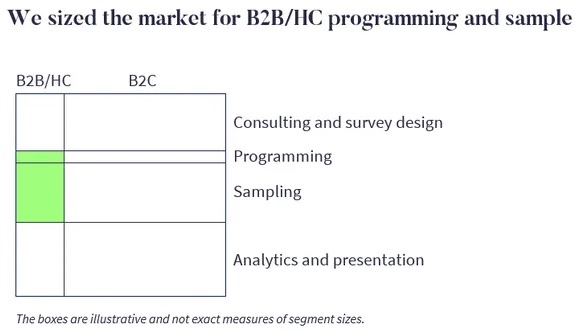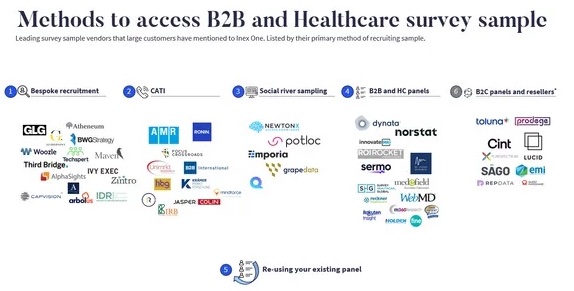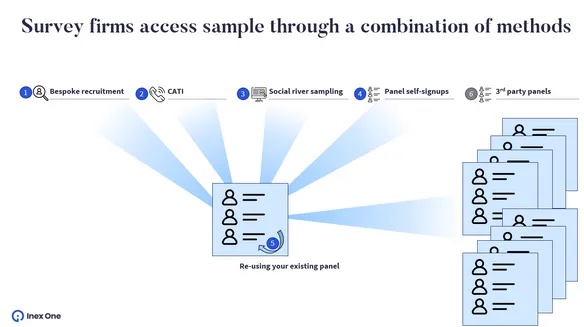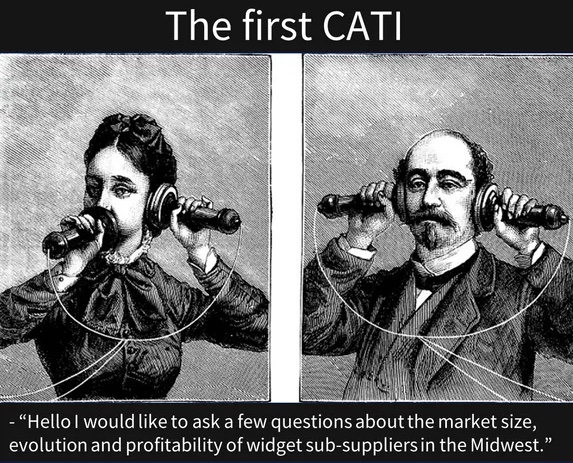Five methods to access survey respondents
Editor’s note: Max Friberg is the CEO of Inex One. This is an edited version of an article that originally appeared under the title “The B2B and Healthcare survey sampling industry market sizing.”
In 2023, the B2B and health care survey industry reached $1.1 billion, growing by 5% from the previous year. We conducted a comprehensive bottom-up analysis, estimating the B2B survey revenue of 50 leading survey firms, panel providers and expert networks. This research draws upon more than 100 conversations with leaders in the B2B survey industry, and the work we do with the leading B2B survey companies. We’ve compiled a unique set of data combining public, hard-to-reach and proprietary sources to benchmark and sense-check the numbers.
Having done a few years of expert network market reports, this is the first extensive sizing of the B2B and health care survey industry. We welcome feedback, additions and improvement suggestions.
In contrast to B2C surveys, B2B and health care surveys target respondents based on their – typically very specific – professional qualifications. Health care is a large and distinctive (special qualifications and regulations) part of B2B and is therefore often defined separately. In this article, we use B2B to describe all professional segments, including health care.

The B2B survey industry has five main methods to access respondents, with a sixth being access through external panels. These approaches are explained below.
The five ways to access B2B survey sample
When investment firms, strategy consultants or market research firms want to survey professionals, they have five ways to get a hold of them. Here are the vendors that these firms mentioned frequently to us:
 When sizing the B2B and health care survey industry, we exclude companies that primarily resell third-party sample or are primarily B2C, e.g., consumer panels, regular fieldwork companies, exchanges and traditional full-service market research firms.
When sizing the B2B and health care survey industry, we exclude companies that primarily resell third-party sample or are primarily B2C, e.g., consumer panels, regular fieldwork companies, exchanges and traditional full-service market research firms.
The firms are listed by their primary method of recruiting survey respondents. This is a bit simplified, of course. In practice, survey sample providers use multiple methods in parallel. Some firms use social river sampling as the primary method of finding new respondents and combine that method with bespoke recruitment. Many firms also top up their own pool of respondents (whether freshly recruited or from their database) with third-party sample.

Some firms have built an entire business on brokering third-party sample. They focus on client service and consulting, sometimes survey programming and then access respondents from other firms. Many of these firms have bought or developed their own trust scores and high-end fraud detection tools.
To an economist, this division of labor sounds fair, and it often is. But, especially in B2C surveys, excessive third-party sampling has contributed to massive quality and fraud problems that the industry is grappling with. Third-party sampling creates a Russian doll problem when estimating revenue. When sizing the industry, we excluded firms that mostly use third-party sample.
How do firms recruit respondents for B2B surveys?
1. Bespoke recruitment
Bespoke recruitment is done mainly by expert networks. These firms collect detailed profiles and CV history of individuals and qualify them over the phone. This method guarantees high-quality respondents but is also the most expensive way to build a survey panel. Bespoke recruitment of respondents is not an economical way of recruiting an entire survey panel.
The cost of recruiting like this is higher than the CPIs most customers are comfortable with. But expert networks have a growth hack for their survey panels: They build them as a side effect of selling $1,000+/hour expert interviews. Bespoke recruitment is economical when you do expert interviews, which lets you accumulate an expert database that can also be used for B2B surveys.
2. CATI
Telephone survey interviewing has been around for ages. Its popularity got a boost in the 1970s when interviewers started doing Computer-Assisted Telephone Interviews (CATI): Recording responses in real-time and getting guidance on the next questions from a computer. CATI brought big efficiency improvements and has been a core market research method. Most CATI firms focus on political polling and B2C research, but some firms also have a material B2B business.
 CATI has long been an established survey method.
CATI has long been an established survey method.
Today, most large CATI firms operate globally from India, Pakistan and the Philippines, but there are large CATI centers in many OECD countries. At first glance, a CATI center looks like a bespoke recruitment firm: Rows of desks with people in headsets talking to experts/respondents. The main differences are that CATI interviewers are typically temps (“zero-hour contracts”), and projects are sold as complete research pieces (“you will get 400 completes on this in three weeks”) rather than multiple vendors competing to fill them. The majority of CATI business is B2C and political research, but the approach is effective also for B2B surveys.
CATI firms typically don't accumulate databases of respondents but are still effective for projects requiring quick, high-volume data collection from specific respondent groups.
3. Social (online) river sampling
Ever seen hyper-targeted ads on LinkedIn/Facebook asking you to do a survey? That’s social river sampling – an effective way to recruit specific B2B respondents. Social river sampling companies use tech tools as they:
- Generate automated gross lists of people who have the exact CV profile that you want by trawling mostly LinkedIn but also Github, Twitter, etc.
- Attract them to your survey:
- Serve ads.
- Send messages (e.g., DMs/ InMails, e-mail cadences, automated texting).
- Typically ask you to verify your identity with your LinkedIn account, in conjunction with completing the survey.
Social river sampling is like bespoke recruitment, but automation keeps your costs down to a level where you can often source the respondents from scratch. You don’t get as detailed profiles and you’re a little more exposed to bots/fraudulent respondents, but savvy buyers understand that and consider it alongside the – oftentimes lower – price tag.
4. B2B and health care panels
Recruiting people for surveys is costly. What if you could get participants to sign up themselves? Turns out, it's possible! B2C firms recruit consumers en masse through games or online reward pages. Consumers visit these platforms for entertainment or rewards and encounter small polls along the way. So, where on the internet do senior B2B leaders hang out? Well, B2B panel firms have a few hacks for this, for example:
- Social networks or industry guides (ex. some companies offer health care professionals social networking sites, online guides that they can browse for advice or online directories to promote their services).
- Partnerships with other firms’ B2B communities. Like Dynata’s partnerships with some airlines, which let Dynata send surveys directly to business travelers and reward them with air miles.
5. Reusing your panel
On top of recruiting new respondents using the methods above, any B2B or health care survey firm worth its salt has a database. This is where they store respondents they’ve previously engaged with. These respondents’ profiles improve over time, as each respondent takes more surveys. This is called a knowledge graph, creating returns to scale for survey firms as they grow (provided they don’t churn the respondents!)
How to access high-quality respondents for your survey
All these methods are established and proven ways to access B2B and health care survey respondents. Different vendors have specialized in different recruitment methods, and each built a database and industry knowledge reflecting the type of survey projects they’ve done historically. Therefore, the survey firm that is best suited can vary between projects.
